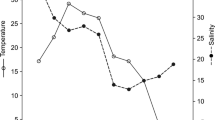Conclusions
-
1.
The abundant mussel fouling of the surfaces of the trash racks, gates of the dam and turbines, concrete scroll cases of the units, and technical water supply system at the Tsimlyansk station results from the favorable physicochemical conditions for development of the mussel. During the season the fouling biomass reaches 11–12 kg/m2.
-
2.
Industrially produced antifouling enamels KhS-522, KhS-79 blue, KhV-53, and KF-751 can be used to protect underwater structures from fouling by mussels. Paints with organotin toxins KhS-521 with TBTO, KhS-519, KhS-519 r. 23, and Kch-520 are also promising, but need further testing.
-
3.
Antifouling enamels should be applied on stable anticorrosion coatings on a vinyl (KhS-720, KhV-74) and epoxy (ÉP-44) base, and also on coatings on a base of enamels KhS-416, KhS-413, etc.
-
4.
Metal structures can be protected against mussel fouling by cathodic means with constant polarization at current densities of 0.4–0.8 A/m2.
-
5.
It was established for the first time that complete protection from fouling is possible with periodic polarization once every 10 days for 8 h at a current density of 4 A/m2. This regime should be maintained for 3–4.5 months a year at the time of intense fouling.
-
6.
The possibility of using antifouling coatings along with cathodic protection from corrosion was investigated. It was established that enamel KhS-522 operating with polarization by a current density of 0.02–0.06 A/m2 for 2 years completely retained its antifouling properties and did not show any traces of damage.
Similar content being viewed by others
Literature cited
Biology of the Mussel and Its Control [in Russian], Nauka, Moscow-Leningrad (1964).
T. I. Malysheva and M. A. Luchina, “Use of organic coatings for protecting metal structures of river hydrodevelopments from corrosion and fouling,” Gidrotekh. Stroit., No. 3 (1974).
E. S. Gurevich, M. A. Dolgopol'skaya, E. D. Izral'yants, and S. P. Sal'nik, “New problems in the development of effective antifouling paints in connection with the problem of environmental protection,” Biol. Morya (1975).
Technical Hydrobiology [in Russian], Vol. 16, Dnepropetrovsk (1975).
Instructions for Cathodic and Organic Coating Protection of Metal Structures at River Hydrodevelopments from Fouling by Mussels [in Russian], Energiya, Leningrad (1972).
I. K. Rzhepishevskii, “Use of cathodic protection for controlling fouling of seagoing ships coated with antifouling paint KhV-53,” Okeanologiya,16 (1976).
Additional information
Translated from Gidrotekhnicheskoe Stroitel'tsvo, No. 8, pp. 25–28, August, 1978.
Rights and permissions
About this article
Cite this article
Luchina, M.A., Malysheva, T.I., Frost, E.I. et al. Means for protecting underwater structures at the Tsimlyansk hydroelectric stations from fouling by mussels. Hydrotechnical Construction 12, 788–793 (1978). https://doi.org/10.1007/BF02304394
Issue Date:
DOI: https://doi.org/10.1007/BF02304394




